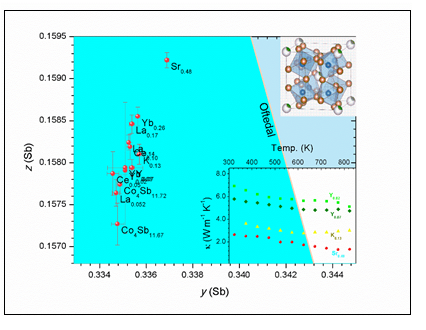
Oftedal plot, including the Oftedal line for y+z= 0.5, corresponding to square Sb4 rings, for the differently filled skutterudite phases prepared under high-pressure. For strontium (Sr), the filling factor is the highest, and simultaneously the Sb4 rings approach a square shape and the band convergence is reached, realized in the best power factor for all the studied skutterudites. Upper inset: skutterudite structure; lower inset: thermal conductivity of differently filled materials.
Cerdanyola del Vallès, 15th July 2020 Skutterudite materials based on cobalt antimonide (CoSb3) are promising semiconductors for thermoelectric applications: they permit the direct conversion of temperature gradients into usable electric energy. In the framework of sustainable technologies, the particular advantages of thermoelectric devices, such as reliability, endurance, vibration and pollution-free operation, promote them for power generation, refrigeration and temperature control applications.
Well-known due to their superior electrical properties are the CoSb3-based skutterudites. In this study, simultaneously optimizing the carrier concentration and lowering the thermal conductivity is addressed in filled-CoSb3, the investigation of which has led to remarkable improvements of the thermoelectric transport properties.
An exhaustive structural characterization by Synchrotron X-ray Powder Diffraction at the MSPD beamline of different filled CoSb3 skutterudites, with a panoply of inserted atoms of different chemical nature (yttrium, potassium, strontium, lanthanum, cerium, ytterbium), has allowed researchers to deepen into the effects of filling from a crystallo-chemical point of view. The crystal structure of these skutterudites materials offers a big empty space volume in which one can insert – fill – various atoms. The idea is that depending on the atoms added in this space, the physical properties can be optimized.
So, researchers report on the high-pressure synthesis and the investigation of the crystallographic structure and thermoelectric properties of these filled MxCo4Sb12 skutterudites, where M are the different atoms inserted. The analyses focus on the correlation of chemical and structural features with the enhanced thermoelectric properties displayed by the certain families of filled-CoSb3 skutterudites. These are mainly determined by antimonium positional parameters, yielding to Oftedal plots that depend on the filling fraction, ionic state and atomic radius of the filler. Together with the distortion of Sb4 rings and CoSb6 octahedra present in the skutterudite structure, these results are linked to the band-convergence concept and its influence on the thermoelectric transport properties.
Scientists have discovered, for instance, a phase segregation effect in the potassium and strontium filled specimens that accounts for the extraordinary reduction in the thermal conductivity, attaining record-low values for skutterudites. That was thanks to the extreme angular resolution of the MSPD diffractometer, allowing researchers the observation of splitting or shoulders on the high-angle reflections, characteristic of the coexistence of two M-rich and M-poor phases. Moreover, the evolution of the structural parameters suggests a main dependence on the filling fraction, regardless of the cationic size or valence state of the filler, explain the researchers.
Synthesis and other conclusions of the skutterudite materials' analysis in detail
The covalent skutterudite framework, defined in the cubic space group Im-3, consists of strongly tilted CoSb6 octahedra that conforms antimony Sb4 rings. The term “filled” is used to indicate that the 2a positions are fully or partially occupied by a foreign cation called the “rattler”. The vibration of this cation in the oversized 2a cages contributes to a significant reduction of the lattice thermal conductivity, acting as a sink for the phonons. Filling the CoSb3 framework with heavy cations yields to n-type doped semiconductors, in which the carrier concentration is optimized via the filling fraction, restricted by the filling fraction limit or using additional doping at Co or Sb positions.
Synchrotron X-ray Powder Diffraction (SXRPD) data collected at MSPD diffractometer with the MAD detector permits to perform an exhaustive and detailed analysis of the slightest structural changes suffered by the skutterudite structure with much better angular resolution than that reported until now. This set of information is related to the chemical changes that have been described in relation to band convergence and increased density of states in the conduction band and the thermoelectric transport properties of the differently filled compounds. The main results are: i) the observation of phase segregation in the potassium and strontium filled specimens accounts for the extraordinary reduction in the thermal conductivity, down to 1.2 W m-1 K-1 for Sr0.5Co4Sb12 at 800 K; ii) small filler elements like yttrium (Y3+) act as ineffective rattlers, hardly decreasing the thermal conductivity; iii) the expansion of the unit cell (quantified by the a parameter) scales with the filling fraction, refined from the SXRPD data, independently (in a first approximation) of the charge or ionic size of the filler element; iv) those compositions with the highest filling fraction (strontium sample) exhibit the best power factor, because they correspond to more regular Sb4 rings, approaching the square form, for which a band convergence and optimal thermoelectric parameters have been estimated; v) the nominal valence of the filler elements certainly influences the charge transfer to the CoSb3 network, observing improved Seebeck coefficients for potassium (K+) > strontium (Sr2+) > ytterbium (Y3+); vi) in the Oftedal plot, the materials with the best performance are ordered following the sequence strontium (Sr2+) > ytterbium (Yb2+) > , lanthanum (La3+) > cerium (Ce3+).
This research is led by the Instituto de Ciencia de Materiales de Madrid (ICMM-CSIC) in collaboration with the Universidad Complutense de Madrid, the Universidad de Castilla-La Mancha and the ALBA Synchrotron.
Reference:Javier Gainza, Federico Serrano‐Sánchez, João E. Rodrigues, Jesús Prado‐Gonjal, Norbert M. Nemes, Neven Biskup, Oscar J. Dura, José L. Martínez, François Fauth, José A. Alonso. Unveiling the Correlation between the Crystalline Structure of M‐Filled CoSb3 (M = Y, K, Sr) Skutterudites and Their Thermoelectric Transport Properties. Advances Functional Materials (2020). DOI: 202001651.




